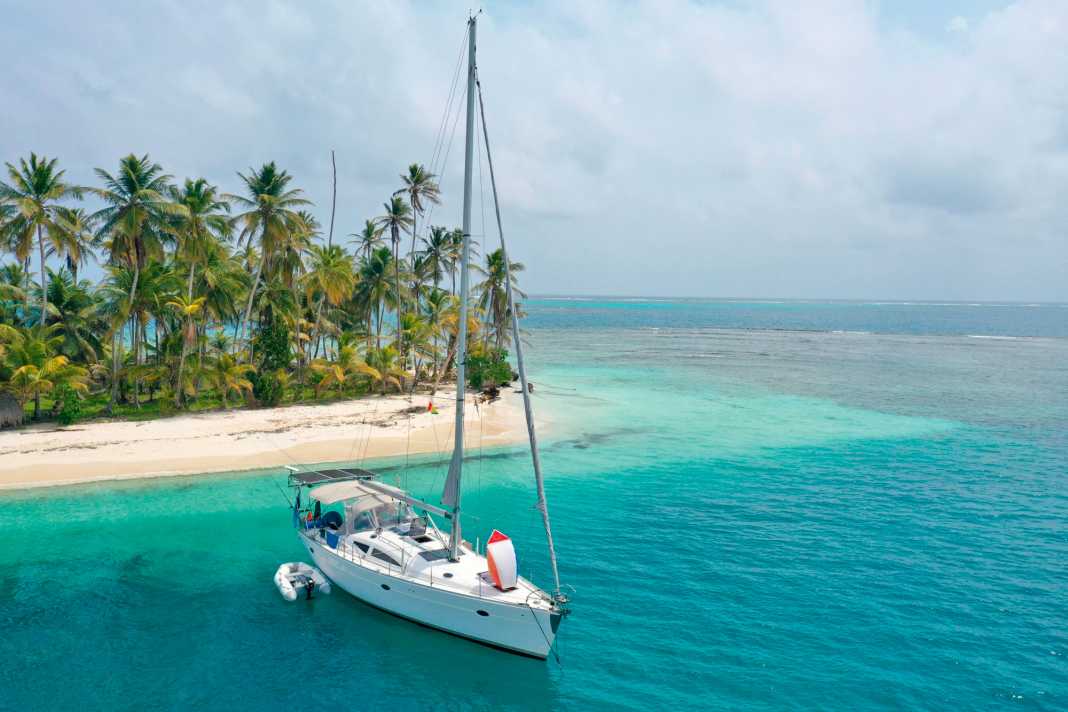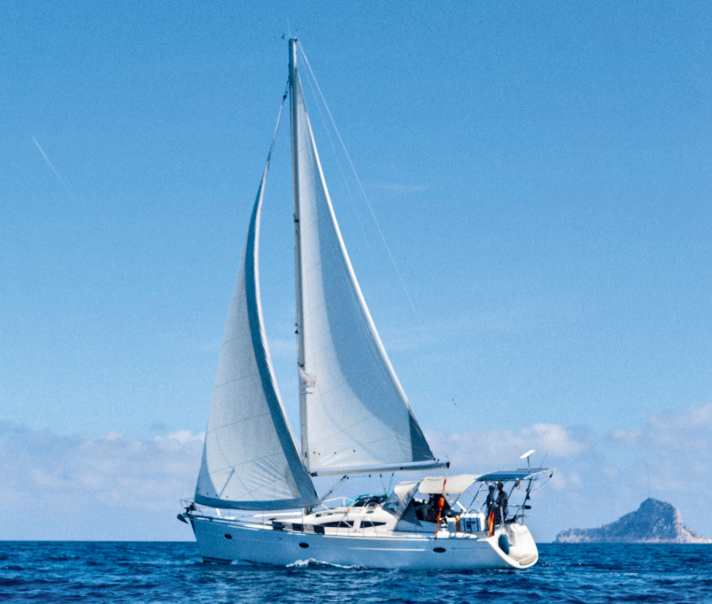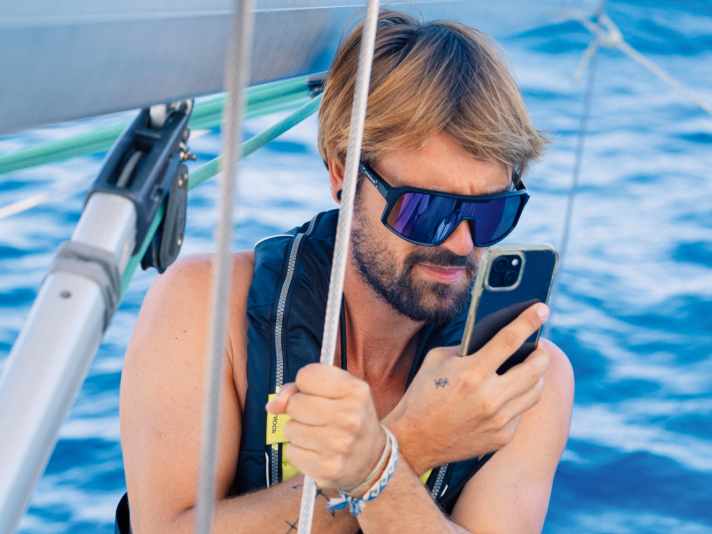Interview Salty Brothers: Three friends sail around the world - and on social media






Sailing across oceans, living in dreamlike anchorages, overwhelming joy and bitter setbacks - the circumnavigation of the world by the "Salty Brothers" captivates tens of thousands. The three young men from southern Germany have been sailing around the world since the summer of 2023. Nicolas Ahlbrecht from Heidelberg, Stephan "Steph" Radegast from Pappenheim and Robert Müller from Utting, all around 30 years old, have been sharing the adventure with their Elan Impression 434 "Pepper" on social media.
And they are extremely successful. They have over 52,000 followers on their Instagram channel "Salty Brothers" and over 20,000 on YouTube. Since setting off from Spain, they have sailed 15,000 nautical miles and are now moored in the Tuamotu archipelago in the South Pacific. Here, at anchor in Makemo Atoll, they revealed in an interview with YACHT how they fulfilled their lifelong dream at a young age, why sailing across the Atlantic and Pacific was very different to what they expected and why their growing popularity on social media surprises them.
YACHT: You have half the world in your wake and are now exploring the remote islands in the Pacific. Is the journey going as well as you hoped, or are there also downsides?
Steph: Of course, there's always something that doesn't go so well. It's annoying when things break on the boat or when - as on the Pacific crossing - you have to sail against the clock for a week. Then you want to go home to the sofa. But then we wouldn't be experiencing this place!
Nico: The bottom line is that everything is going very, very well.
Robert: Many people think that we go on holiday for three years. Very few people realise that sailing around the world is also a lot of work. There is always something to do to keep the boat running so that no maintenance backlog builds up.
You bought your boat, an Impression 434 from Elan, just a few months before you started travelling. Was it a good choice for you?
Robert: Yes, the boat actually found us. We were in Almerimar to view another one. But we cancelled it because too many defects quickly became apparent. Then we got a tip on the spot that an older Norwegian couple had arrived a few days earlier and wanted to sell their boat. It appealed to us, our gut feeling was right and the previous owners were very open.
Nico: But of course it's a 20-year-old boat, and the fact that a cable corrodes from time to time is just part of it.
Steph: We use it intensively, it works 24 hours a day, it never takes a break.
What criteria played a role in the search for the boat?
Steph: Robert and I had previously sailed a lot on sporty yachts on the Baltic Sea. That's why we were initially looking for a rather sporty or at least special boat. But then common sense prevailed. Our current boat is a good compromise.
Robert: We wanted to have at least three cabins and preferably a fourth one for guests, which we could alternatively use for storage.
Do you often have fellow sailors visiting?
Steph: Yes, I would say that we are not alone on board 80 per cent of the time. At the moment, it's just the three of us on board for the first time since the end of January. We have lots of friends and acquaintances who sail and like to come along for a bit. This takes a lot of pressure off the on-board budget and helps us with the financial planning of the trip. However, we have never taken strangers with us.
It takes a lot to sail around the world with guests. You have to stick to deadlines, even if the weather doesn't play ball, and you're always sharing your living space with other people. Does that work well for you?
Nico: It would actually be more relaxed if we didn't do it. It's always about: when do I drop who off and where do I pick up the next ones? In the beginning, we also misjudged ourselves, timed everything far too tightly and got a bit of a mess.
What happened?
Nico: The weather wasn't right when we had to sail through the Strait of Gibraltar towards the Canary Islands. We laboured at 30 knots to get there in time because there were already people waiting. And then we were too late after all! But that was also due to the fact that we lost the propeller and had to get a replacement and attach it in a rush. However, the advantage of sailing with guests is that they keep reminding us how indescribable this journey is, which is now part of our everyday lives. That always gives us new energy.
In your three-man crew "Salty Brothers", you have two experienced sailors, Stephan and Robert, and a sailing novice, Nico. How does that work - is there a clear division of roles?
Nico: We don't have fixed roles, everything has grooved according to our strengths and preferences. I tend to stay out of sailing. Instead, I focus on other things like maintaining the engine or watermaker. When we redid the underwater hull, I had my hat on. Robert, for example, is a chronic weather report watcher anyway (laughs), so he usually takes care of it.
What weather conditions have you had so far? Was it as you would expect sailing the barefoot route to be, or were there any surprises?
Robert: It was different than expected. Steph and I had each sailed across the Atlantic twice before in both directions on a traditional sailing boat. There we got to know the classic trade wind weather. Not at all now! Instead, we bobbed around for days in a huge calm area and were able to go swimming. We went through pretty much everything with the sails and tried everything, sometimes changing two, three or four times a day. Spinnaker, genoa, double genoa - we were constantly tinkering around.
Apart from the unpredictable wind conditions, which did you like better, crossing the Atlantic on the tall ships or on your own boat?
Robert: Here on your own boat, you always have an eye or an ear open, even if you're not on watch. That's the biggest difference. In return, we can do whatever we want on board and stay as long as we want - apart from any appointments. But we can make very flexible decisions and only have to decide between the three of us. That's an advantage and a real luxury.
Steph: In any case, long legs on the larger boats were much more relaxed than on our 44-footer. The division of labour is completely different as there are only three of us here. Fortunately, there were five of us on the Pacific crossing, so it was relaxed.
You were already familiar with the Atlantic, but the Pacific was a new territory for you. What was that like?
Robert: The Pacific crossing was much better! For one thing, we already had ocean experience on our boat. And our two female co-sailors on the Pacific, both experienced sailors, were a tremendous help. Nevertheless, the first thousand miles to Galapagos were still tough; a cross with lots of wind and waves, rain and thunderstorms. And that for ten days in a row! It really wasn't cosy, it was a tough start to the Pacific crossing. After the Galapagos Islands, however, the conditions improved significantly.
Steph: We finally found the trade wind on the south side of the equator and were then able to head west. It was pretty pleasant sailing, almost like a Baltic summer ... Nico: The last week was even more strenuous, with more wind and the highest waves of the trip so far, up to five metres. When we realised that the electric autopilot wasn't going to make it to the Marquesas, we steered by hand for the last three days. Luckily there were five of us!
This Pacific crossing was also a milestone for you in other respects. Your social media presence as "Salty Brothers" is very successful. Was your presence there part of the journey from the start?
Robert: Yes, that was part of it for us. The sailing boys were definitely an inspiration. By the time we crossed the Pacific, we had around 3,000 or 4,000 followers. The huge increase only came from the videos that we published daily on the Pacific passage. There was always a daily video on various topics. Some of them went viral, one has almost three million views. As a result, we gained almost 50,000 new followers within 30 days. I can't understand it myself, it's crazy.
Your followers are probably not all sailors. What are they particularly interested in about your trip, what do they ask you most often?
Nico: For example, how we go to the loo. And why we don't sleep in hammocks when we're at sea so much. And of course the classics: Where do you anchor at night on the Atlantic? What do you do in storms? What do you do when the waves are high? What do you do if your boat sinks?
You've now arrived in the Tuamotu archipelago and are planning to sail to the Society Islands and then to New Zealand. How do you continue there?
Steph: From now on, we no longer have any firm plans, just ideas. We want to be in New Zealand at the end of October. The ship will stay there during the cyclone season. Up to this point, we had financed the trip with savings, but now we have to use the break from sailing to work and earn money.
And the itinerary?
Steph: In May or June next year, we want to leave New Zealand heading north towards Fiji, from there we will continue westwards and through the Suez Canal into the Mediterranean, if the political situation allows. After setting off from Almerimar in Spain, we sailed a test race around Sardinia. Our starting line was between Bonifacio and Sardinia. We want to cross this line again.
You've already travelled halfway round the world. What does it feel like, how has the journey changed you?
Robert: That's not an easy question!
Steph: She made you spontaneous!
Robert: That's right. And it has helped me to appreciate many, many things that I take for granted at home. For example, a washing machine. Steph: I also struggled with spontaneity at first. You simply can't plan many things. Or you plan and everything turns out differently. You first have to grow into this life in harmony with nature and the boat. The weather does what it wants and determines everything. If the boat is fine, we're fine.
Nico: I had a lot of time to think about and reflect on myself, for example with regard to my previous career choices. I am now very aware of what I am looking for in my future. There is an extreme difference between taking a two-week holiday and, like us now, really being away for a while.
The yacht "Pepper

The boat for the trip is an Elan Impression 434 built in 2006, which was chartered for a long time before being taken over by a cruising couple from Norway, who sold it to the "Salty Brothers". The 12.99 metre long ship is powered by a 55 hp Volvo in calm conditions, is 4.20 metres wide and has a draught of 1.90 metres. The boat was designed by Rob Humphreys and built at the Elan shipyard in Slovenia.
Salty Brothers: travelling virtually

Nicolas Ahlbrecht, 29, Stephan Radegast, 29, and Robert Müller, 31, worked as gardeners and landscapers, architects and photographers before their big trip. While travelling, they pursue their passion for filming and photography and share their travel experiences on Instagram and YouTube: @saltybrotherssailing.

